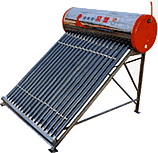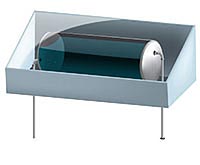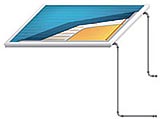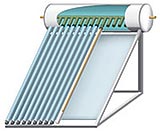Solar Water Heating Systems
While there are many different types of solar water heating systems, there is a common method to how they work. Most are simple in design and inexpensive to install. In general, the sunlight passes through a collector and the radiation that is absorbed by the collector is usually converted to heat in a liquid transfer medium or through the air. The radiation can also be used to heat the water directly.
Solar water heating systems can be active or passive to transfer the heat. An active solar water heating system uses pumps to transfer heat from the collector to the storage tank. Active systems can use a PV module to produce the electricity to run an electric pump motor.
In a passive system, the system does not use pumps or control mechanisms to transfer the heat created to the storage tank. Instead, passive systems use natural forces such as gravity to circulate the water. There is also an exchange/storage tank of some kind. When such systems are used for bigger buildings that house businesses or offices, there is often more than one storage tank for the water.
There are several types of solar water heating systems:
Direct Systems
 Direct systems use a pump to circulate the water. The water moves from the home into a water storage tank and passes through the solar collectors for heating. After it leaves the collector, the water returns to a tank. From there, it is pumped back into the house as hot water. The pump can be powered by a PV cell or by an electronic controller or appliance timer. Direct systems are usually used in warm climates with few or no days in which the temperature dips below freezing. Because of this requirement, there is a very limited area where direct systems can be used, at least in the United States.
Direct systems use a pump to circulate the water. The water moves from the home into a water storage tank and passes through the solar collectors for heating. After it leaves the collector, the water returns to a tank. From there, it is pumped back into the house as hot water. The pump can be powered by a PV cell or by an electronic controller or appliance timer. Direct systems are usually used in warm climates with few or no days in which the temperature dips below freezing. Because of this requirement, there is a very limited area where direct systems can be used, at least in the United States.

Indirect Systems
Indirect systems use a heat exchanger that is separate from the solar collector. The collector contains an antifreeze solution instead of the water to be heated. The heat exchanger transfers the heat from the collector's antifreeze solution to the water located in the water storage tank. The heat exchanger can either be inside the storage tank or outside the storage tank. One advantage to this system is that it can be used in areas where the temperature falls below the freezing point.
Thermosyphons
 A thermosyphon solar water heating system features an insulated storage tank that is placed above the solar collector, usually a flat-plate collector. When the sun hits the collector, it warms the water located in the tubes that pass through the collector. This water travels up through the top of the storage tank, which is insulated, and out through a hot water pipe. At the bottom of the storage tank is the cold water, which travels down through a pipe and into the collector. Sometimes, a small pump can be added to this system if it is not possible to place the tank on the same level or below the collectors. This system can only be used in warmer climates where temperatures remain above freezing.
A thermosyphon solar water heating system features an insulated storage tank that is placed above the solar collector, usually a flat-plate collector. When the sun hits the collector, it warms the water located in the tubes that pass through the collector. This water travels up through the top of the storage tank, which is insulated, and out through a hot water pipe. At the bottom of the storage tank is the cold water, which travels down through a pipe and into the collector. Sometimes, a small pump can be added to this system if it is not possible to place the tank on the same level or below the collectors. This system can only be used in warmer climates where temperatures remain above freezing.
Draindown/Drainback Systems
Draindown systems are often used in cold climates. In this system, water passes through the collector to be heated. Draindown systems prevent water from freezing inside the collector by the use of electric valves. These valves automatically remove the water from the collector if the temperature gets too cold. The drainback system is very similar to the draindown system. When the circulating pump that is part of the drainback system stops as a result of cold.
Integral Collector Storage (ICS) Systems
 These types of systems are also known as integrated collector systems, batch heaters, bulk storage systems, or breadbox heaters. Whatever the name, the ICS system features a collector and 40-gallon (151-liter) insulated storage tank that are part of one unit. The tank is lined inside with glass and painted black to draw in the sun's heat. The ICS system is usually placed on a roof or in a place on the ground where there is sunlight. Cold water comes into the ICS system from the plumbing in the house. The inlet inside the tank pushes the water to the bottom of the tank. The hot water rises in the tank and goes into the building through an outlet. There can also be a backup tank below the ICS unit that transfers water to be heated when the already heated water is taken from the primary storage tank. One drawback to this system is that the hot water created by the ICS system should be used during the afternoon or evening hours. If it is not, it should be transferred into another storage tank before nightfall. Otherwise, the water in the primary storage tank might lose much of its heat overnight, especially in cold weather.
These types of systems are also known as integrated collector systems, batch heaters, bulk storage systems, or breadbox heaters. Whatever the name, the ICS system features a collector and 40-gallon (151-liter) insulated storage tank that are part of one unit. The tank is lined inside with glass and painted black to draw in the sun's heat. The ICS system is usually placed on a roof or in a place on the ground where there is sunlight. Cold water comes into the ICS system from the plumbing in the house. The inlet inside the tank pushes the water to the bottom of the tank. The hot water rises in the tank and goes into the building through an outlet. There can also be a backup tank below the ICS unit that transfers water to be heated when the already heated water is taken from the primary storage tank. One drawback to this system is that the hot water created by the ICS system should be used during the afternoon or evening hours. If it is not, it should be transferred into another storage tank before nightfall. Otherwise, the water in the primary storage tank might lose much of its heat overnight, especially in cold weather.
Swimming Pool Systems
 The solar energy systems used to heat swimming pools and hot tubs are usually simpler than other kinds of solar water heaters, but just as effective. The use of a solar water heater can allow an outdoor pool or hot tub to be used for at least four months longer than a pool or hot tub without a heater. The system usually consists only of a temperature sensor, an electronic controller, a pumping system, and solar collectors. The collectors can be mounted on the pool's deck, on the ground, or on a roof. Most collectors used for pools or hot tubs usually have no glass covering or insulation. They are also usually lowert emperature collectors. That is, they usually are designed only to raise the temperature of the pool's water to about 80 to 100F (26 to 37C). This system does not need a storage tank since the pool or hot tub serves as the storage medium.
The solar energy systems used to heat swimming pools and hot tubs are usually simpler than other kinds of solar water heaters, but just as effective. The use of a solar water heater can allow an outdoor pool or hot tub to be used for at least four months longer than a pool or hot tub without a heater. The system usually consists only of a temperature sensor, an electronic controller, a pumping system, and solar collectors. The collectors can be mounted on the pool's deck, on the ground, or on a roof. Most collectors used for pools or hot tubs usually have no glass covering or insulation. They are also usually lowert emperature collectors. That is, they usually are designed only to raise the temperature of the pool's water to about 80 to 100F (26 to 37C). This system does not need a storage tank since the pool or hot tub serves as the storage medium.
Pumped Systems
There are also pumped systems intended for bigger buildings, such as hotels and gymnasiums. In this type of system the storage tank is located inside the building and uses a pump to transfer water between the collectors and the tank. In addition, a controller is needed that detects when the water in the panels is hotter than the water in the tanks. The controller regulates the pump so that the temperatures remain correct. If the outside temperature gets below freezing, the pump starts running to prevent the water from freezing.
Flat plate collectors
 The most common type of energy collector, the flat plate collector, is a rectangular-shaped box that is put on the roof of the home or building where the solar water heating system is located. Inside the box is a thin absorber sheet, usually black in color and made of either copper or aluminum. Behind the sheet is a tubing system in the form of a grid or coils. The collector and tubing system are put inside an insulated casing. The cover is usually glass and transparent. This glass is often black or a dark color that draws in the sunlight.
The most common type of energy collector, the flat plate collector, is a rectangular-shaped box that is put on the roof of the home or building where the solar water heating system is located. Inside the box is a thin absorber sheet, usually black in color and made of either copper or aluminum. Behind the sheet is a tubing system in the form of a grid or coils. The collector and tubing system are put inside an insulated casing. The cover is usually glass and transparent. This glass is often black or a dark color that draws in the sunlight.
As the sun shines, the heat builds up in the collector and heats the fluid that is inside the tubes. If it is water, it is heated and passes through a storage tank. If the fluid inside is antifreeze, the water is heated by circulating the heated solution through a tube inside the storage tank in which the water is located.
Evacuated tube collectors
 This type of collector features rows of glass tubes placed parallel to each other with a vacuum between them that insulates the tubes and helps hold on to the heat. The tubes are also transparent and covered with a coating. Inside each tube is an absorber with liquid inside it. When light from the sun hits the tube and its radiation is absorbed by the absorber, the liquid inside is heated. Because of the vacuum between the tubes, this liquid can be heated to very high temperatures, up to 350F (176C). Though the evacuated tube collectors can achieve high temperatures, they are more fragile than other types of solar collectors and more expensive.
This type of collector features rows of glass tubes placed parallel to each other with a vacuum between them that insulates the tubes and helps hold on to the heat. The tubes are also transparent and covered with a coating. Inside each tube is an absorber with liquid inside it. When light from the sun hits the tube and its radiation is absorbed by the absorber, the liquid inside is heated. Because of the vacuum between the tubes, this liquid can be heated to very high temperatures, up to 350F (176C). Though the evacuated tube collectors can achieve high temperatures, they are more fragile than other types of solar collectors and more expensive.
Advantages and Disadvantages of Solar Water Heating Systems
Solar water heating systems have existed for many years. They are used in homes, businesses, schools, office buildings, prisons, military bases, and industrial settings. Solar water heating systems can be used to power irrigation systems, and they can also be used to provide water for livestock on farms and ranches. Solar hot water heating systems are often used where natural gas or electricity cannot be used to heat water.
For a typical household, solar water heating systems can provide from 70 to 90 percent of the hot water needed for bathing and laundry. They are relatively easy to install in both new and existing homes and buildings. Because of the variety of systems available, at least one type will work in most locations. The systems are long-lasting, with most systems lasting a minimum of fifteen to twenty years. Passive solar water heating systems in particular are very inexpensive because of the limited equipment involved and the little maintenance required.
However, certain types of solar water heating systems cannot be used in freezing temperatures, limiting the area in which solar technology can be used. Some types of solar water heaters cannot work as well or at all when it is cloudy. Because of the variations in temperatures and sunlight in most parts of the world, solar water heating systems sometimes need a backup water heating system to ensure the availability of hot water at all times.
Solar Water Heating Systems copyright 2011 Digtheheat.com
